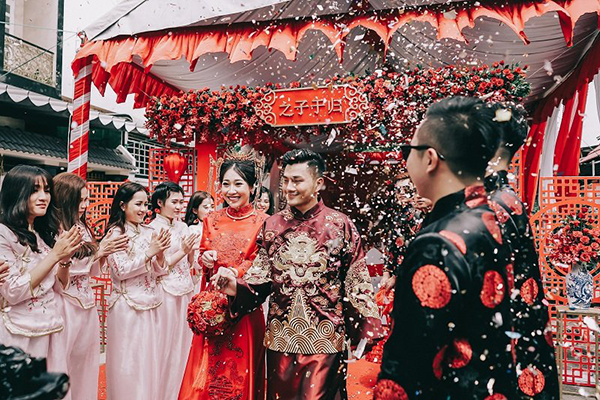The Hoa people, also known as Vietnamese Chinese (Vietnamese: Người Hoa, Chinese: 華人; pinyin: Huárén or Chinese: 唐人; Jyutping: tong4 jan4) are the citizens and nationals of Vietnam of full or partial Han Chinese ancestry. Chinese migration into Vietnam dates back millennia but allusions to the contemporary Hoa today mostly refers to people of Chinese ancestry who immigrated to Vietnam during the 18th century, who especially trace their ancestry to various southern Chinese provinces. The Hoa are an ethnic minority group in Vietnam as part of the Chinese community there, and can also be found in other regions such as in the Americas. They may also be called “Chinese-Vietnamese” or “Vietnamese Chinese” by the Vietnamese.
Historically, the first wave of Chinese migrants into Vietnam brought Chinese-oriented cultural, religious and philosophical thought to Vietnam, where the Vietnamese gradually developed and adapted such elements to systematically its own. Beginning as early as the 19th century, the Hoa people were known during the French Indochina era for being favoured by the French colonial rulers. Despite subsequent backlash that followed this, the Hoa community still exists in contemporary Vietnamese society today, either as descendants of Han Chinese who have immigrated to Vietnam over the nation’s history or as more recent immigrants.
During prehistoric times in the Red River Delta basin, there were two main language families present. One being the Austroasiatic family from which the native modern Vietnamese language is descended, and the other being influenced by the Sino-Tibetan culture and language by the Chinese-speaking Han immigrants into Vietnam.
The Hoa, especially those of more recent Han Chinese extraction who settled in Vietnam since the 18th century, have played a leading role in Vietnam’s private business sector before the end of the Vietnam War in 1975 and the reunification of Vietnam. However, many Hoas from South Vietnam had their businesses and property confiscated by the North Vietnamese Communist Party after 1975 and fled the country, as well as the South Vietnamese who faced persecution by the Communist Government. This was then intensified during the Sino-Vietnamese War. From the Vietnamese Communist government point of view, the Chinese disloyal to Vietnam were regarded with deep suspicion, and had potentially teamed up with the French occupiers in seizing control of Vietnam’s resources and labour, an almost repeat of the forces of Japanese imperialism leading to the Vietnamese famine of 1945, resulting in 2 million deaths of the Vietnamese populace.
From the late 19th century, the Hoa played a leading role in Vietnam’s private business sector prior to the Fall of Saigon in 1975. They were a well-established commercial middle class ethnic group that made up a disproportionately high percentage of Vietnam’s upper class. Despite their small numbers, the Hoa were disproportionately dominant in the Vietnamese economy having started an estimated 70 to 80 percent of pre-fall Saigon’s privately owned and operated businesses. Communist intervention was then deemed necessary by wide swathes of the Vietnamese population and is considered to be an ingrained symbol of the Vietnamese identity by some.[8] Many Hoa had their businesses and property confiscated by the Communists after 1975, and many fled the country as boat people due to persecution by the newly established Communist government. Hoa persecution intensified in the late 1970s, which was one of the underlying reasons for the Sino-Vietnamese War.
The Vietnamese government’s shift to economic liberalization since late 1986 has revived the entrepreneurial presence of the predominantly urban Chinese minority allowing them reassert much of their previous economic clout in the Vietnamese economy. However, contemporary Hoa economic clout however pales in comparison to their previous influence that they once held prior to 1975, where modern Vietnam has mostly diversified its economy, allowing the presence of global corporations to operate within the country.
Migration history
Early history
According to folklore, prior to Chinese domination of northern and north-central Vietnam, the region was ruled by a series of kingdoms called Văn Lang with a hierarchical government, headed by Lạc kings (Hùng kings), who were served by Lạc hầu and Lạc tướng. In approximately 257 BCE, Văn Lang was purportedly annexed by the Âu Việt state of Nam Cương. These Âu Việt people inhabited the southern part of the Zuo River, the drainage basin of the You River and the upstream areas of the Lô, Gâm, and Cầu Rivers, according to Đào Duy Anh. The leader of the Âu Việt, Thục Phán, overthrew the last Hùng kings, and unified the two kingdoms, establishing the Âu Lạc polity and proclaiming himself King An Dương (An Dương Vương).
After independence
Sporadic Chinese migration into Vietnam continued between the 9th and 15th centuries AD. The Vietnamese court during the Lý dynasty and the Trần dynasty welcomed ethnic Chinese scholars and officials to fill into its administrative and bureaucratic ranks, but these migrants had to renounce their Chinese identity and assimilate into Vietnamese society. The Vietnamese court also allowed Chinese refugees, which consisted of civilian and military officials with their family members to seek asylum in Vietnam. However, these Chinese settlers were not allowed to change their place of residence without the Court’s permission and were also required to adopt Vietnamese dress and culture. During the Early Lê dynasty some Chinese were captured in 995 after the Vietnamese raided the border. During the Lý dynasty Vietnam raided Song dynasty China to enslave Chinese, who were forced to serve in the Vietnamese army as soldiers.
15th–18th centuries
Lê dynasty
After the Fourth Chinese domination of Vietnam it was recorded that the union of Vietnamese women and Chinese (Ngô) men produced offspring which were left behind in Vietnam and the Chams, Cẩu Hiểm, Laotians, these people and Vietnamese natives who collaborated with the Ming were made into slaves of the Le government in the Complete Annals of Đại Việt.
There was no mandatory required reparation of the voluntarily remaining Ming Chinese in Vietnam. The return of the Ming Chinese to China was commanded by the Ming and not Lê Lợi. The Trai made up the supporters of Le Loi in his campaign. He lived among the Trai at the border regions as their leader and seized the Ming-ruled lowland Kinh areas after originally forming his base in the southern highland regions. The southern dwelling Trai and Red River dwelling Vietnamese were in effect locked in a “civil war” during the anti-Ming rebellion by Le Loi.
Statehood under North Vietnam and South Vietnam: 1950–1975
At a party plenum in 1930, the Indochinese Communist Party made a statement that the Chinese were to be treated on an equal footing with the Vietnamese, specifically defining them as “The workers and laborers among the Chinese nationals are allies of the Vietnamese revolution”. One year after the state of North Vietnam was established, a mutual agreement was made between the Chinese Communist Party and Communist Party of Vietnam to give ethnic Chinese living in North Vietnam Vietnamese citizenship. This process was completed by the end of the 1950s.
Đổi Mới (since 1986)
After Nguyễn Văn Linh initiated the Vietnamese economic reforms in 1986, the Hoa in Vietnam has witnessed a massive commercial resurgence and despite many years of persecution began to regain much of their power in the Vietnamese economy. The open-door policy and economic reforms of Vietnam, as well as the improved economic and diplomatic relations of Vietnam with other Southeast Asian countries, has revived much of the entrepreneurial presence and economic clout of the predominantly urban Hoa minority in the roles they had played in the Vietnamese economy prior to 1975.
Diaspora communities
Today, there are many Hoa communities in Australia, Canada, France, United Kingdom and the United States, where they have reinvigorated old existing Chinatowns. For example, the established Chinatowns of Los Angeles, San Francisco, New York City, Houston, Chicago, Dallas, Toronto, Honolulu and Paris have a Vietnamese atmosphere due to the large presence of Hoa people. Some of these communities also have associations for transplanted Hoa refugees such as the Association des Résidents en France d’origine indochinoise in Paris.
Orange County, California, is also home to a significant Hoa diaspora community, along with Cabramatta, New South Wales, Australia and Mississauga, Ontario, Canada.
The Chinese Vietnamese population in China now number up to 300,000, and live mostly in 194 refugee settlements mostly in the provinces of Guangdong, Guangxi, Hainan, Fujian, Yunnan and Jiangxi. More than 85% have achieved economic independence, but the remainder live below the poverty line in rural areas. While they have most of the same rights as Chinese nationals, including employment, education, housing, property ownership, pensions, and health care, they had not been granted citizenship and continued to be regarded by the government as refugees. Their refugee status allowed them to receive UN High Commissioner for Refugees (UNHCR) assistance and aid until the early 21st century. In 2007, the Chinese government began drafting legislation to grant full Chinese citizenship to Indochinese refugees, including the ethnic Hoa which make up the majority, living within its borders.
source: https://en.m.wikipedia.org/wiki/Hoa_people



